| Dan's Double Push Stripped Bare, made possible by the generous support of Alan Bragman, Lynn Durkee, Brian Arnell, Tony Johnson, Ray Pisar, James Babkes, and Daniel R. Dugan. |
 After pushing fully, Dan sets skate down slightly pigeon-toed to initiate the double push |
Picture 1- The left skate set-down stops Dan's "fall" and starts the first of two pushes per leg. His set-down occurs on the outside edge of his wheels. His skate is slightly pigeon-toed, allowing him to position his skate under his body mass for easier overcommitment of body weight and quicker pressure initiation. The shadow shows Dan's center of mass lined up over his back three wheels. | |
Picture 2- The fall and underpush are happening simultaneously. Isometric at first, then extending, the abbreviated underpush is directed both laterally and forward so that the center of mass falls outside and slightly behind the base of support (see shadow). The right skate is moving swiftly to recover behind the left skate, adding momentum to the fall and push. | 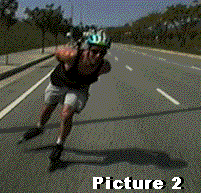 Double push central. Dan extends strongly with a crossover-like push while the right skate recovers. | |
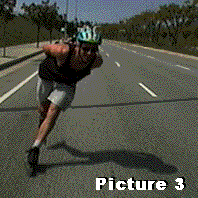 Full D.P. extension, both forward and laterally |
Picture 3-Full underpush extension is a position of extreme instability! Dan will fall over unless he recovers his skate back under his center of mass. His heel carve points his skate diagonally back across his direction of travel. Dan's center of mass is at its farthest point behind the left skate, or base of support. His underpush is at full extension (see how his pushing leg is fully straight). The right skate is fully over-recovered at height of the underpush. Now's the time to release the carving pressure and take advantage of relative unweightedness to steer the skate back in. | |
Picture 4 The second "recovery" has taken place as Dan's base of support (skate) is now directly under his center of mass. In other words, while his skate traveled a longer diagonal path, his body caught up. It's his second time through the vertical axis on the same leg. Now he needs knee flexion. That's what he's loading up on here, knee flexion, getting ready for a classic push with power.(The more upright body position of the double push gives a shorter classic push, however the addition of the double push gives a sum greater than a classic push alone.) | 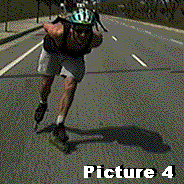 Dan's leg recovers directly under his body and reloads for the classic push to the outside. |
|
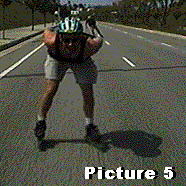 Gravity aided mass transfer from pushing skate to support skate | Picture 5-Classic "fall"-Dan's center of mass literally falls to the inside of the base of support with good body alignment (nose-knee-toes). Notice the nose-knee-toe alignment in all of the pictures! This tells us that all of the pressure is directed through the long axis of the body. Adductors and abductors aren't doing the work. They're acting as aides to the primary movers, the hip and leg extensors. Note that Dan's right skate is not weighted yet. That would interrupt the momentum he's generating with his regular fall and push. | |
Picture 6- Classic push with full leg extention to the outside. Dan's ankle is straight and his wheels are aligned almost vertically to the pushing surface at maximum extension. This allows him to push harder through the long axis of his leg without losing traction or power to pronation. Dan sets his right skate down slightly pigeon-toed, so there's no steering necessary to position his skate for the underpush. | 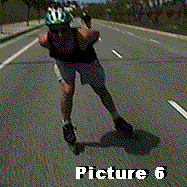 Regular push with set-down preparing for D.P. |
If you can connect an underpush and a regular push back to back repeatedly on one leg, you will have unlocked the secret of the double push! |
| Copyright 1999 - 2000 Eddy Matzger Workshop. All rights reserved worldwide. |